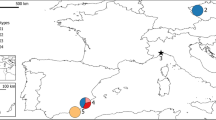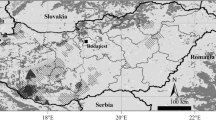Abstract
We investigated the genetic structure of Sorex unguiculatus and Sorex caecutiens populations in Hokkaido, Japan, using hypervariable microsatellite DNA markers. We used five microsatellite loci to type 475 S. unguiculatus individuals from 20 localities on the Hokkaido mainland and four localities from each of four offshore islands (and 11 shrews from one locality in southern Sakhalin for a particular analysis). We used six microsatellite loci to type 240 S. caecutiens individuals from 13 localities on the Hokkaido mainland. Genetic variation was high in mainland populations of both species and low in the island populations of S. unguiculatus. Allelic richness and island size were positively correlated for S. unguiculatus, suggesting that genetic drift occurred on those islands due to small population size. In addition, four insular populations of S. unguiculatus were genetically differentiated from the mainland populations, although clear phylogeographic clustering was not confirmed among populations on the Hokkaido mainland for either S. unguiculatus or S. caecutiens. Heterozygosity excess was observed in more than half of the populations including the mainland populations of the two species, suggesting recent bottleneck events in these populations. Population dynamics of the shrews might be explained by a metapopulation scheme. According to autocorrelation analysis, the extent of non-random spatial genetic structure was approximately 100 km. Isolation by distance was observed in S. unguiculatus, but not in S. caecutiens although there is a positive trend. The lack of correlation for S. caecutiens might have been due to small sample size. Thus, no obvious differences in population genetic structure were found between the two species on the Hokkaido mainland in the present study, while previous investigations using mitochondrial DNA sequences inferred that these two species might have rather different biogeographic histories.






Similar content being viewed by others
References
Animal Care Use Committee (1998) Guidelines for the capture, handling, and care of mammals as approved by the American Society of Mammalogists. J Mamm 79:1416–1431
Avise JC (2000) Phylogeography: the history and formation of species. Harvard University Press, London
Balloux F, Lugon-Moulin N (2002) The estimation of population differentiation with microsatellite markers. Mol Ecol 11:155–165
Brunhoff C, Galbreathk E, Fedorov VB, Cook JA, Jaarola M (2003) Holarctic phylogeography of the root vole (Microtus oeconomus): implication for late Quaternary biogeography of high latitudes. Mol Ecol 12:957–968
Burton C, Krebs CJ, Taylor EB (2002) Population genetic structure of the cyclic snowshoe hare (Lepus americanus) in south–western Yukon, Canada. Mol Ecol 11:1689–1701
Cavalli-Sforza LL, Edwards AWF (1967) Phylogenetic analysis: models and estimation procedures. Evolution 32:550–570
Cornuet JM, Luikart G (1996) Descritption and power analysis of two tests for detecting recent population bottlenecks from allele frequency data. Genetics 144:2001–2014
Di Rienzo A, Peterson AC, Carza JC, Valdes AM, Slatkin M, Freimer NB (1994) Mutational processes of simple-sequence repeat loci in human population. Proc Natl Acad Sci USA 91:3166–3170
Dolgov VA (1985) Shrews of the old world. Moscow State University Press, Moscow
El Mousadik A, Petit RJ (1996) High level of genetic differentiation for allelic richness among populations of the argan tree [Argania spinosa (L.) Skeels] endemic to Morocco. Theor Appl Gene 92:832–839
Felsenstein J (2002) PHYLIP (Phylogeny Inference Package), version 3.6a3. Department of Genetics, University of Washington, Seattle, Wash.
Goldstein DB, Schlotterer C (1999) Microsatellite: evolution and applications. Oxford University Press, New York
Goodman SJ, Tamate HB, Wilson R, Nagata J, Tatsuzawa S, Swanson GM, Pemberton JM, McCullough DR (2001) Bottlenecks, drift and differentiation: the population structure and demographic history of sika deer (Cervus nippon) in Japanese archipelago. Mol Ecol 10:1357–1370
Goudet J (2001) FSTAT, a program to estimate and test gene diversities and fixation indices, version 2.9.3. Institut d’Ecologie, Universite de Lausanne, Lausanne
Hanski I (1999) Metapopulation ecology. Oxford University Press, New York
Hänfling B, Hellemans B, Volckaert FAM, Carvalho GR (2002) Late glacial history of the cold adapted freshwater fish Cottus gobio, revealed by microsatellites. Mol Ecol 11:1717–1729
Hewitt G (2000) The genetic legacy of the Quaternary ice age. Nature 405:907–913
Hutchison DW, Templeton AR (1999) Correlation of pairwise genetic and geographic distance measures: inferring the relative influences of gene flow and drift on the distribution of genetic variability. Evolution 53:1898–1914
Igarashi Y (2000) Geohistorical and paleoecological significance of South Kuril Islands; especially on connection with Hokkaido Island (in Japanese). Wildl Forum (Sapporo) 6:1–21
Japan Association for Quaternary Research (eds) (1987) Quaternary maps of Japan (with explanatory text in Japanese; in Japanese and English explanation for maps). University of Tokyo Press, Tokyo
Lugon-Moulin N, Brünner H, Wyttenbach A, Hausser J, Goudet J (1999) Hierarchical analyses of genetic differentiation in a hybrid zone of Sorex araneus (Insectivora: Soricidae). Mol Ecol 8:419–431
Lugon-Moulin N, Hausser J (2002) Phylogeographical structure, postglacial recolonisation and barriers to gene flow in the distinctive Valais chromosome race of the common shrew (Sorex araneus). Mol Ecol 11:785–794
Luikart G, Allendorf FW, Cornuet JM, Sherwin WB (1998) Distortion of allele frequency distributions provides a test for recent population bottlenecks. J Hered 89:238–247
Mantel N (1967) The detection of disease clustering and a generalized regression approach. Cancer Res 27:209–220
Masuda R (1999) Blakiston’s line and genetic investigation on biogeography of mammals in Japan (in Japanese). Honyurui Kagaku (Mammal Sci) 39:323–328
Masuda R, Yoshida MC (1994) A molecular phylogeny of the family Mustelidae (Mammalia, Carnivora), based on comparison of mitochondrial cytochrome b nucleotide sequences. Zool Sci 11:605–612
Naitoh Y, Ishibashi Y, Abe S, Ohdachi SD (2002) Isolation and characterisation of polymorphic microsatellite DNA markers in two shrew species, Sorex unguiculatus and S. caecutiens. Mol Ecol Not 2:434–436
Naitoh Y, Iwasa MA, Ohdachi SD, Han SH, Suzuki H (2005) Restriction fragment length polymorphism of nuclear rDNA in Sorex caecutiens/shinto group (Eulipotyphla, Soricidae) Mammal Study 30:101–107
Nesterenko VA (1999) Insectivores of the south Far East and their communities (in Russian). Dalnauka, Vladivostok
Ohdachi S (2005) History of community organization of shrews in Hokkaido, inferred from DNA. In: Masuda R, Abe H (eds) Natural history of animal biogeography (in Japanese). Hokkaido University Press, Sapporo, pp 15–31
Ohdachi S, Maekawa K (1990) Geographic distribution and relative abundance of four species of soricine shrews in Hokkaido, Japan. Acta Theriol 35:261–267
Ohdachi S, Masuda R, Abe H, Adachi J, Dokuchaev NE, Haukisalmi V, Yoshida MC (1997) Phylogeny of Eurasian soricine shrews (Insectivora, Mammalia) inferred from the mitochondrial cytochrome b gene sequences. Zool Sci 14:527–532
Ohdachi S, Dokuchaev NE, Hasegawa M, Masuda R (2001) Intraspecific phylogeny and geographic variation of six species of northeastern Asiatic Sorex shrews based on the mitochondrial cytochrome b sequences. Mol Ecol 10:2199–2213
Ohdachi SD, Abe H, Han SH (2003) Phylogenetical positions of Sorex sp. (Insectivora, Mammalia) from Cheju Island and S. caecutiens from the Korean Peninsula, inferred from mitochondrial cytochrome b gene sequences. Zool Sci 20:91–95
Ohshima K (1990) The history of straits around the Japanese Islands in the late-Quaternary (in Japanese with English abstract). Quat Res (Daiyonki Kenkyu) 29:193–208
Ohnishi N (2002) The genetic population structures of small rodents in Hokkaido. PhD thesis, Graduate School of Agriculture, Hokkaido University, Japan
Peakall R, Smouse PE (2001) GenAlEx V5: genetic analysis in Excel. Population genetic software for teaching and research. Australian National University, Canberra
Peakall R, Ruibal M, Lindenmayer DB (2003) Spatial autocorrelation analysis offers new insights into gene flow in the Australian bush rat, Rattus fuscipes. Evolution 57:1182–1195
Pritchard JK, Wen W (2004) Documentation for structure software, version 2. Software available at http://pritch.bsd.uchicago.edu. Department of Human Genetics, University of Chicago, Ill.
Pritchard JK, Stephens M, Donnelly P (2000) Inference of population structure using multilocus genotype data. Genetics 155:945–959
Queney G, Ferrand N, Weiss S, Mougel F, Monnerot M (2001) Stationary distributions of microsatellite loci between divergent population groups of the European Rabbit (Oryctolagus cuniculus). Mol Biol Evol 18:2169–2178
Raymond M, Rousset F (1995) GENEPOP version 1.2: population genetics software for exact tests and ecumenicism. J Hered 86:248–249
Rousset F (1997) Genetic differentiation and estimation of gene flow from F-statistics under isolation by distance. Genetics 145:1219–1228
Sambrook J, Fritsch EF, Maniatis T (1989) Molecular cloning: a laboratory manual, 2nd edn. Cold Spring Harbor Laboratory Press, Cold Spring Harbor, N.Y.
Shackleton NJ (1987) Oxygen isotopes, ice volume and sea level. Q Sci Rev 6:183–190
Triantafyllidis A, Krieg F, Cottin C, Abatzopoulost J, Triantaphyllidis C, Guyomard R (2002) Genetic structure and phylogeography of European catfish (Silurus glanis) population. Mol Ecol 11:1039–1055
Walsh PS, Metzger DA, Higuchi R (1991) Chelex 100 as a medium for simple extraction of DNA for PCR-based typing from forensic material. Bio Tech 10:506–513
Weir BS, Cockerham CC (1984) Estimating F-statistics for the analysis of population structure. Evolution 38:1358–1370
Whitlock MC (2004) Selection and drift in metapopulations. In: Hanski I, Gaggiotti OE (eds) Ecology, genetics, and evolution of metapopulations. Elsevier, New York, pp 153–173
Wright S (1943) Isolation by distance. Genetics 6:111–178
Wyttenbach A, Favre L, Hausser J (1997) Isolation and characterisation of simple sequence repeats in the genome of the common shrew. Mol Ecol 6:797–800
Acknowledgements
We thank A. J. Davis, M. J. Toda and M. T. Kimura for comments on an early version of the manuscript. Y. Ishibashi and M. A. Iwasa gave us useful suggestions throughout the field and laboratory work. H. Abe, N. E. Dokuchaev, S. H. Han, K. Nakata, T. Saitoh, and K. Takahashi provided shrew samples. N. Etoh gave technical assistance in the laboratory experiments. T. Inuzuka, K. Kawai, C. Kawakubo, M. Kita, S. Kuroda, M. Noro, Y. Ohta, K. Okamura, H. Satoh, I. Satoh, M. Senda, W. Shimojima, K. Shishido, M. Tanizaki, T. Tohsuji and H. Tomizawa supported our field work. I. Hanski and G. Hinten gave us suggestions about population genetic analyses. Part of the study was supported by a Grant-in-Aid for Scientific Research of the Japan Society for Science Promotion. We followed the American Society of Mammalogists guidelines for animal treatment (Animal Care and Use Committee 1998) in this study.
Author information
Authors and Affiliations
Corresponding author
About this article
Cite this article
Naitoh, Y., Ohdachi, S.D. Population genetic structure of Sorex unguiculatus and Sorex caecutiens (Soricidae, Mammalia) in Hokkaido, based on microsatellite DNA polymorphism. Ecol Res 21, 586–596 (2006). https://doi.org/10.1007/s11284-006-0154-1
Received:
Accepted:
Published:
Issue Date:
DOI: https://doi.org/10.1007/s11284-006-0154-1




